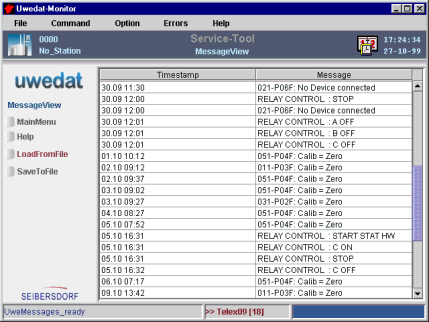
None
Analog-Digital Converter, this electronic components are used to digitize analogous measuring-signals and make them readable to microprocessors. Depending on the required accuracy the digitizing is performed with 8, 16 or 24 bit resolution.
an important message, sent imediately to the central monitoring system
Dragging is used to move an object on the screen from one location to another. Dragging is also used to resize an object by moving the objects border. Click and hold down the mouse button to move or resize an object.
A focus is a visible border or color-effect emphasizing preselected controls
A filter is used to prevent invalid character-input. The set of valid characters are usually annotated with rectangular brackets, for instance
[0-9], [ASCII 32-127]
Final-Values are the result of the signal-postprocessing. Post-processing is used for data-correction by applying calibration-values, or if the use of different technical units is required for data-evaluation (i.e. ppm versus µg, or m/sec versus km/h).
A Graphical User Interface (GUI) allows the user to interact with the system in a shophisticated way.
Halfhour-Meanvalues (HMV) are the result of the standard data-processing. The environmental monitoring system is capable to store up to 21 days of HMV for up to 48 components.
A component may be a physical or a logical component. For instance the wind-gust is described by 3 logical components: wind-gust, related wind-direction and related time-marking of the occurence.
A progress-bar is an indicator showing the progress of timeconsuming operations
Raw-Values are the result of the signal-conversion - the electrical input-signal is converted in technical units by use of a polynomial. For instance the signal-voltage of the temperature-sensor is converted in °Celsius.
RS-232 is a communication-link used for data-transfer over short distances (suitable for up to 15 meters of cable-length).
The sub-identifier is used to distinguish devices of same type. The unique Device ID consists of two digits describing the type of measuring device (ie. temperature sensor = 13) and a sub ID from 1 - 9.
The task-bar is used by the operating system (ie. Win98, WinNT) to indicate running user-applications. A small part of the task-bar is provided for system-activities, for instance time-display.
A hooverhelp or tooltip is used to explain abbreviations or technical expressions
A User Password is required to access data or execute operations
Variable-Meanvalues (VMV) are the result of user-defined data-processing. VMVs may be established for up to 8 components. The storage of VMVs depends on the number of components and the choosen time-interval.
The environmental monitoring system is capable to store exactly 3 days of VMV for 8 components with measuring-intervals of 1 minute. If the number of components is decreased, or the time-interval is increased, the storage-capacity will increase accordingly.
For detailed information see the W3C homepage at
www.w3.orgNot yet implemented
Uwedat® Servicetool
Message-View
The Message-View shows recorded error-event messages. These detailed informations are usefull for maintenance and data-quality prove. The environmental monitoring station is capable to record up to 50 message-events.
Description

Datafields
The message-table consists of two columns, the first column shows the time-marking and the second column shows the description of the message event. The messages are sorted by time-marking, you can scroll through the message list and you can re-sort the messages by event-types in alphabetical order.
 Time-marking
This display-field indicates the time and date the message-event has occured at. Time-marking
This display-field indicates the time and date the message-event has occured at.
The date-format is DD-MM (day-month)
The time-format is 24 hours from 00:01 to 24:00
|
 Message
This display-field shows the event-message. The message consist of a coded identification of the event-source (ie. measuring-interface 021-P06F) and an event-description in plain text (ie. Device not connected). Message
This display-field shows the event-message. The message consist of a coded identification of the event-source (ie. measuring-interface 021-P06F) and an event-description in plain text (ie. Device not connected).
|
 Sorting
The messages are sorted by time-markings in ascending order (new messages first). You can re-sort the messages in descending order (oldest message first) by double-click on the time-marking table-head. Another way to sort is the alphabetical order of message-text, this is done by double-click on the message table-head. Sorting
The messages are sorted by time-markings in ascending order (new messages first). You can re-sort the messages in descending order (oldest message first) by double-click on the time-marking table-head. Another way to sort is the alphabetical order of message-text, this is done by double-click on the message table-head.
|
Menu
File Dialog
The look and behaviour of the file-dialog depends on the operation system of your Service-Tool PC. The example shows a file-dialog used with the operation system MS Windows.

|
 Top of document
Top of document



